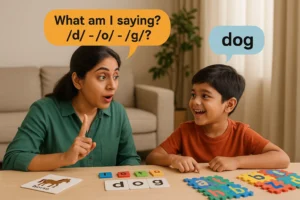
Source: scholastic
Phonics Rules play a key role in streamlining the word structure using sounds of English letters. Children can readily decipher words and enhance their reading capability by grasping Phonics Rules. These rules provide a foundation for determining word patterns, aiding learners in specifying how different letter combinations form distinct sounds.
Phonics Rules gives students the confidence to expand their language with ease. Comprehending these rules lets learners envision the sounding of unknown words, making reading more comforting and less intimidating. As children practice Phonics Rules, they develop robust reading aptitudes that influence overall academic success.
What are the Basic Rules in Phonics?
Learners can become expert readers by understanding how letters and sounds work jointly and learning the basic Phonics Rules.
The Basic Rules in Phonics are:
Vowel in Every word
Vowels are indispensable to form syllables and whole words.
Long vowels
A vowel is articulated like its name, such as “a” in “take.”
Silent e
A word concluding in a silent “e” generally makes the vowel sound long, for example- tape.
The schwa sound
A weak, light vowel sound, like the “a” in “sofa.”
Vowels in syllables
Every syllable is incomplete without a vowel.
Consonant digraphs
Two consonants create a single sound. For instance- sh, ch, th, etc.
Ending in ck or k
ck or k often comes after a short vowel sound, such as “luck,” “duck,” etc.
R-controlled vowels
The letter r modifies the vowel sound, like in a car, tar, jar, etc.
Soft c and soft g
C makes an “s” sound and G produces a “g” sound when it is ahead of “e,” “i,” or “y,” For instance- cell, giraffe, etc.
These Phonics Rules simplify the learning approach, thus unlocking the enigma of reading success.
Click Here, to download Best Phonics Course brochure!
For more details of Best Phonics Course, Call / Whatsapp on +919869866277 / +919869546913.

What are the 12 Rules of Spelling?
English Spelling has numerous irregularities, but diverse Rules of Spelling lower these complexities and make it more effortless to spell words correctly and unassisted.
Here are the 12 Rules of Spelling to follow:
“i before e, except after c”
This rule aids in recalling that the “ie” sequence is used in words like believe and chief, while “ei” is put upon after “c” as in ceiling, receive, etc.
Double the concluding consonant
- When a vowel and a consonant are at the end in a one-syllable, double the last consonant then add a suffix.
- Examples include stiff- stiffen, spell- spelling, pass- passed, etc.
Remove the final e when adding a suffix beginning with a vowel
Remove e at the end when adding a suffix that begins with a vowel, such as hope- hoping, hoped.
Alter ‘y’ to ‘i’
When a word ends with y, replace it with i when adding a suffix. For example, hurry- hurried.
U always comes after Q
In English, the letter letter “U” always comes after “Q.” For instance, “quick,” “queen,” etc.
C is articulated as /s/ before e, i, or y
The letter “C” produces the /s/ sound before “e,” “i,” or “y,” as seen in words like city and cereal.
G sounds /j/ before e, i, or y
When “G” comes before “e,” “i,” or “y,” it is articulated as /j/, such as in “gentle” or “giant.”
Use ‘ck’ after a short vowel
Use “ck” to spell the last consonant after a short vowel sound. For instance, duck, sick, tick, etc.
Silent letters
Specific letters in words are not said. Typical examples include “kn” in know, “wr” in the wrist, “mb” in the thumb, etc.
Every syllable has at least one vowel
At least one Vowel Sound in every syllable assures that each element of the word is pronounceable.
At least one vowel in every word
Every word in English has at least one vowel.
Double ‘f’, ‘l’, and ‘s’ at the end of a monosyllabic word
- When a monosyllabic word has a single vowel, double the final f, l, or s before adding a suffix.
- Examples- stiff, spell, pass, etc.
These Phonics Rules help streamline the complexities of English spelling and make it more straightforward to interpret difficult words. These approaches can result in more uniform and accurate spelling.

Source: istockphoto
What are the Rules for Pronouncing Y in English?
The Pronunciation of Y becomes tricky due to its multiple sounds. By learning the Phonics Rules children can easily learn the multiple pronunciations of Y in English and enhance their reading and speaking ability.
The principal Phonics Rules for Pronouncing Y in English to keep in mind are:
“Y” as a vowel
Y sounds like a long e sound and behaves as a vowel at the end of a word. Example- happy, family, etc.
“Y” as a consonant
It usually produces a /y/ sound, when a word or a syllable commences with Y, like in yellow, yoga, etc.
“Y” as a long “i” sound
Y can resemble a long I sound at times, especially at the end of words or syllables. For instance- cry, my, fry, etc.
“Y” in the middle of words
In the middle of words, “Y” sounds like the long “e” sound, like in “typical” or “cycle.”
Proficiency in these Phonics Rules can make a big difference when articulating words with “Y.” For those wishing to teach others how to enunciate it correctly, pursuing Phonics Teacher Training Courses can be a facilitatory step. Vidhyanidhi Education Society (Govt. Regd.) presents Phonics Teacher Training Courses that cover the key elements of phonics, including the pronunciation of untrusty letters like “Y.”
For anyone wishing to become a phonics teacher, Vidhyanidhi Education Society provides (Govt. Regd.) Phonics Teacher Training Courses that provide educators with the tools to guide students in mastering spoken language. These Phonics Teacher Training Courses are perfect for those eager to amplify their phonics knowledge and enhance Phonics Rules teaching methods, ensuring that both teachers and students benefit from a profound knowledge of English pronunciation rules.
Join Vidhyanidhi’s Best Phonics Course, master alphabet sounds & transform teaching!
Click Here, to download Best Phonics Course brochure!
For more details of Best Phonics Course, Call / Whatsapp on +919869866277 / +919869546913.
FAQs
How to Start Teaching Phonics?
Begin with letter sounds, teach simple consonant-vowel combinations, and use engaging activities like songs and games to reinforce learning.
What is Phonics in English?
Phonics is the pedagogy approach to guide learners to decipher words using distinct sounds of letters.
Is Phonics a Skill?
Yes, phonics is a key skill that lets learners decode words by comprehending the association between letters and their sounds.



